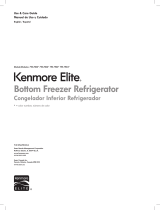
Food Storage Tips
Food How To
Freezing
Packaging
The following tips may not be applicable depending
on the model.
Wrap or store food in the refrigerator in airtight and
moisture-proof material unless otherwise noted.
This prevents food odor and taste transfer
throughout the refrigerator. For dated products,
check date code to ensure freshness.
Keep opened butter in a covered dish
or closed compartment. When
storing an extra supply, wrap in a
freezer packaging and freeze.
Store in the original wrapping until
you are ready to use it. Once
opened, rewrap tightly in plastic
wrap or aluminum foil.
Wipe milk cartons. For coldest milk,
place containers on an interior shelf.
Store in original carton on interior
shelf, not on door bin.
Do not wash or hull the fruit until it is
ready to be used. Sort and keep fruit
in its original container, in a crisper,
or store in a completely closed paper
bag on a refrigerator shelf.
Remove store wrapping and trim or
tear off bruised and discolored areas.
Wash in cold water and drain. Place
in plastic bag or plastic container and
store in crisper.
Place in plastic bags or plastic
container and store in crisper.
Store fresh fish and shellfish in the
freezer section if they are not being
consumed the same day of
purchase. It is recommended to
consume fresh fish and shellfish the
same day purchased.
Cover leftovers with plastic wrap or
aluminum foil, or store in plastic
containers with tight lids.
Butter or
Margarine
Cheese
Milk
Eggs
Fruit
Leafy
Vegetables
Vegetables
with skin
(carrots,
peppers)
Fish
Leftovers
Your freezer will not quick-freeze a large quantity of
food. Do not put more unfrozen food into the freezer
than will freeze within 24 hours [no more than 2 lbs
(0,9 kg) to 3 lbs (1,3 kg) of food per cubic foot of
freezer space]. Leave enough space in the freezer
for air to circulate around packages. Be careful to
leave enough room at the front so the door can close
tightly.
Storage times will vary according to the quality and
type of food, the type of packaging or wrap used
(how airtight and moisture-proof) and the storage
temperature. Ice crystals inside a sealed package
are normal. This simply means that moisture in the
food and air inside the package have condensed,
creating ice crystals.
NOTE
Allow hot foods to cool at room temperature for
30 minutes, then package and freeze. Cooling hot
foods before freezing saves energy.
Successful freezing depends on correct packaging.
When you close and seal the package, it must not
allow air or moisture in or out. If it does, you could
have food odor and taste transfer throughout the
refrigerator and could also dry out frozen food.
Packaging Recommendations:
Follow package or container instructions for proper
freezing methods.
Do not use:
Rigid plastic containers with tight-fitting lids.
Straight-sided canning/freezing jars.
Heavy-duty aluminum foil.
Plastic-coated paper.
Non-permeable plastic wraps.
Specified freezer-grade self-sealing plastic bags.
Bread wrappers.
Non-polyethylene plastic containers.
Containers without tight lids.
Wax paper or wax-coated freezer wrap.
Thin, semi-permeable wrap.
Storing Frozen Food
NOTE
Check a freezer guide or a reliable cookbook for
further information about preparing food for
freezing or food storage times.
Adjusting the Refrigerator Shelves
The shelves in your refrigerator are adjustable to
meet your individual storage needs.
Adjusting the shelves to fit items of different heights
will make finding the exact item you want easier.
Doing so will also reduce the amount of time the
refrigerator door is open which will save energy.
16
OPERATION
ENGLISH




















